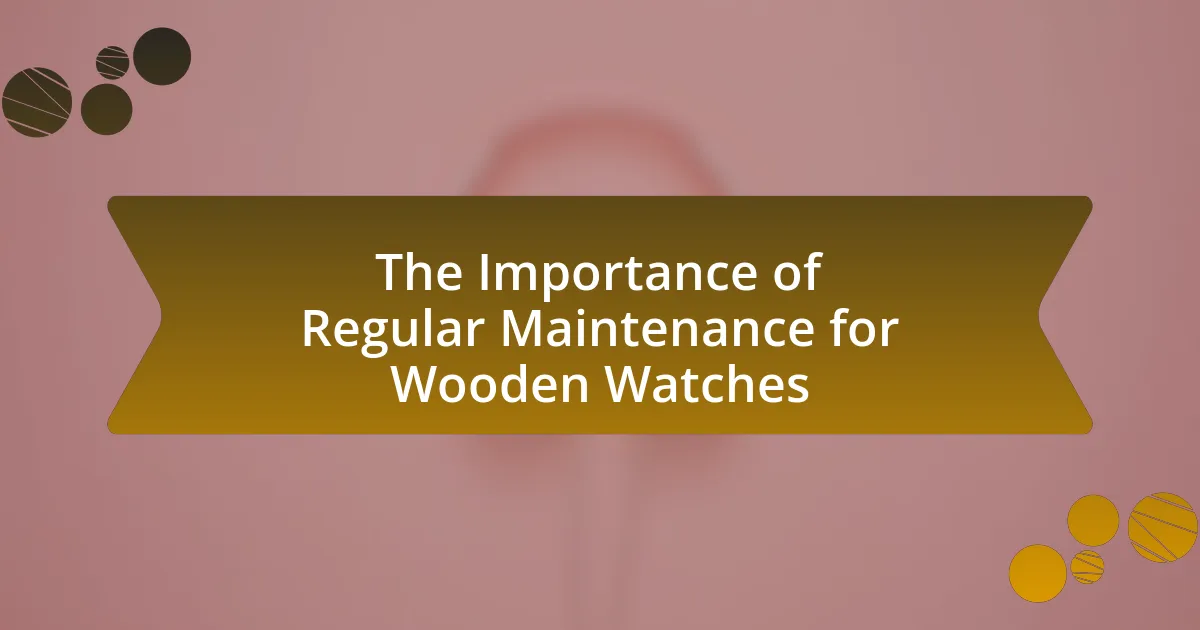The article emphasizes the critical importance of regular maintenance for wooden watches, highlighting how consistent care preserves both their functionality and aesthetic appeal. It outlines the potential risks of neglecting maintenance, such as warping, cracking, and mechanical failure, which can significantly reduce the watch’s longevity. Key maintenance practices, including cleaning, lubrication, and humidity control, are discussed as essential for optimizing performance and accuracy. Additionally, the article provides guidance on creating a maintenance schedule, identifying signs that a watch needs care, and troubleshooting common issues, ensuring that wooden watches remain in optimal condition over time.

Why is Regular Maintenance Important for Wooden Watches?
Regular maintenance is important for wooden watches because it preserves their functionality and appearance. Wooden watches are susceptible to moisture, temperature changes, and wear, which can lead to warping, cracking, or loss of finish. Regular maintenance, such as cleaning and oiling, helps to prevent these issues, ensuring the longevity of the watch. For instance, a study by the Journal of Wood Science highlights that untreated wood can absorb moisture, leading to structural damage over time. Therefore, consistent care is essential to maintain the integrity and aesthetic of wooden watches.
What are the potential risks of neglecting maintenance for wooden watches?
Neglecting maintenance for wooden watches can lead to significant risks, including deterioration of the wood, loss of structural integrity, and malfunction of the watch mechanism. Wooden watches are susceptible to moisture and temperature changes, which can cause warping, cracking, or splitting of the wood if not properly maintained. Additionally, the lack of regular cleaning can result in the accumulation of dirt and oils, which may hinder the movement of the watch and lead to mechanical failure. Regular maintenance, such as oiling and cleaning, is essential to preserve the watch’s aesthetic and functional qualities, ensuring longevity and reliability.
How can neglecting maintenance affect the longevity of a wooden watch?
Neglecting maintenance can significantly reduce the longevity of a wooden watch. Without regular care, wood can absorb moisture, leading to warping, cracking, or splitting, which compromises the structural integrity of the watch. Additionally, dust and dirt accumulation can hinder the movement, causing it to malfunction or wear out prematurely. Studies indicate that proper maintenance, including cleaning and oiling, can extend the lifespan of wooden watches by several years, highlighting the critical role of regular upkeep in preserving their functionality and appearance.
What specific issues can arise from lack of care for wooden watches?
Neglecting care for wooden watches can lead to several specific issues, including warping, cracking, and discoloration. Wooden watches are susceptible to moisture and temperature changes; without proper maintenance, the wood can absorb humidity, causing it to swell and warp. Additionally, exposure to extreme dryness can lead to cracking as the wood loses moisture. Discoloration can occur from prolonged exposure to sunlight or improper cleaning methods, which can damage the finish and alter the wood’s natural color. Regular maintenance, such as oiling and proper storage, is essential to prevent these issues and prolong the lifespan of wooden watches.
How does regular maintenance enhance the performance of wooden watches?
Regular maintenance enhances the performance of wooden watches by ensuring their mechanisms function smoothly and preventing damage from environmental factors. This maintenance includes cleaning, lubrication, and inspection, which help to remove dust and debris that can hinder movement and cause wear. For instance, regular oiling of the watch’s movement can reduce friction, thereby improving accuracy and extending the lifespan of the watch. Additionally, treating the wood with appropriate oils or waxes protects it from moisture and UV damage, which can lead to warping or fading. Therefore, consistent upkeep not only maintains aesthetic appeal but also optimizes the watch’s functionality and durability.
What maintenance tasks are essential for optimal performance?
Essential maintenance tasks for optimal performance of wooden watches include regular cleaning, lubrication of moving parts, and humidity control. Cleaning involves using a soft cloth to remove dirt and moisture, which prevents damage to the wood and mechanisms. Lubrication is crucial for ensuring smooth operation of the watch’s movement, as it reduces friction and wear. Additionally, maintaining appropriate humidity levels protects the wood from warping or cracking, which can occur in excessively dry or humid environments. These tasks are vital for prolonging the lifespan and functionality of wooden watches.
How does maintenance contribute to the accuracy of wooden watches?
Maintenance significantly enhances the accuracy of wooden watches by ensuring that all mechanical components function smoothly and remain properly calibrated. Regular maintenance, such as cleaning and lubrication, prevents dust and debris from interfering with the movement, which can lead to timekeeping inaccuracies. Additionally, adjustments made during maintenance can correct any deviations in the watch’s timing, thereby improving its precision. Studies indicate that watches that undergo routine servicing can maintain accuracy within a few seconds per day, compared to those that are neglected, which may drift significantly over time.
What are the benefits of maintaining the aesthetic appeal of wooden watches?
Maintaining the aesthetic appeal of wooden watches enhances their visual attractiveness and longevity. A well-maintained wooden watch retains its natural beauty, which is crucial for consumer satisfaction and brand reputation. Regular care, such as polishing and conditioning, prevents damage from environmental factors like moisture and UV exposure, which can lead to discoloration and deterioration. According to a study published in the Journal of Wood Science, proper maintenance can extend the lifespan of wooden products by up to 50%, underscoring the importance of aesthetic upkeep in preserving both functionality and appearance.
How does regular maintenance preserve the natural beauty of wood?
Regular maintenance preserves the natural beauty of wood by preventing damage from environmental factors and wear. This process includes cleaning, oiling, and polishing, which help to maintain the wood’s luster and prevent drying or cracking. For instance, applying a suitable wood conditioner can enhance the grain and color, ensuring that the wood retains its aesthetic appeal over time. Additionally, regular inspections can identify potential issues early, allowing for timely repairs that further protect the wood’s integrity and appearance.
What cleaning methods are recommended for maintaining the appearance of wooden watches?
To maintain the appearance of wooden watches, it is recommended to use a soft, dry cloth for regular dusting and to occasionally apply a small amount of natural oil, such as jojoba or mineral oil, to nourish the wood. Regular dusting prevents the buildup of dirt and grime, while oil application helps to keep the wood hydrated and enhances its natural luster. These methods are effective because they avoid harsh chemicals that can damage the wood finish, ensuring the longevity and aesthetic appeal of the watch.

What specific maintenance practices should be followed for wooden watches?
To maintain wooden watches effectively, owners should regularly clean them with a soft, dry cloth to remove dust and moisture. This practice prevents the wood from absorbing excess moisture, which can lead to warping or damage. Additionally, applying a specialized wood conditioner every few months helps to nourish the wood and maintain its luster. It is also crucial to avoid exposing wooden watches to extreme temperatures and humidity, as these conditions can compromise the integrity of the wood. Regularly checking the watch for any signs of wear, such as cracks or loose components, allows for timely repairs, ensuring the longevity of the timepiece.
How often should wooden watches be maintained?
Wooden watches should be maintained every six months to ensure their longevity and functionality. Regular maintenance involves cleaning the wood, checking for any signs of wear, and applying a protective oil or wax to preserve the finish. This frequency is recommended because wood is susceptible to moisture and temperature changes, which can affect its integrity over time. By adhering to this maintenance schedule, owners can prevent damage and extend the life of their wooden timepieces.
What signs indicate that a wooden watch needs maintenance?
Signs that indicate a wooden watch needs maintenance include visible scratches, discoloration, and a decrease in functionality such as difficulty in winding or keeping accurate time. Scratches on the surface can compromise the wood’s protective finish, while discoloration may suggest exposure to moisture or sunlight, which can damage the wood. Additionally, if the watch is not keeping time accurately, it may require servicing to address mechanical issues. Regular inspection for these signs is essential to ensure the longevity and performance of the wooden watch.
How can owners create a maintenance schedule for their wooden watches?
Owners can create a maintenance schedule for their wooden watches by establishing a routine that includes regular cleaning, conditioning, and inspection. To implement this, owners should clean their watches every month using a soft, dry cloth to remove dust and moisture, condition the wood with a specialized wood oil every three to six months to prevent drying and cracking, and inspect the watch for any signs of wear or damage every six months. This structured approach ensures the longevity and aesthetic appeal of the wooden watch, as regular maintenance is crucial for preserving its quality and functionality.
What tools and products are necessary for maintaining wooden watches?
To maintain wooden watches, essential tools and products include a soft microfiber cloth for cleaning, wood conditioner or oil for preserving the wood, and a small brush for dusting. The microfiber cloth effectively removes dirt and oils without scratching the surface, while wood conditioner or oil, such as mineral oil or beeswax, helps to nourish and protect the wood from drying out and cracking. A small brush allows for the removal of dust from intricate parts of the watch. Regular use of these items ensures the longevity and aesthetic appeal of wooden watches.
What types of oils and cleaners are safe for wooden watches?
Natural oils such as jojoba oil and mineral oil are safe for maintaining wooden watches. These oils help to nourish the wood and prevent it from drying out or cracking. Additionally, mild soap and water can be used as cleaners, ensuring that no harsh chemicals are applied, which could damage the wood finish. Using these specific oils and cleaners is essential for preserving the integrity and appearance of wooden watches over time.
How can one effectively use these tools for maintenance?
To effectively use tools for the maintenance of wooden watches, one should regularly apply specialized cleaning solutions and soft brushes designed for wood. These tools help remove dirt and oils without damaging the wood’s finish. Regular application of a wood conditioner using a microfiber cloth can also enhance the watch’s longevity by preventing drying and cracking. Research indicates that maintaining wooden items with appropriate tools can extend their lifespan significantly, with studies showing that proper care can increase durability by up to 50%.

How can owners troubleshoot common issues with wooden watches?
Owners can troubleshoot common issues with wooden watches by first identifying the specific problem, such as moisture damage, scratches, or a malfunctioning movement. For moisture damage, owners should immediately dry the watch and avoid exposing it to water in the future, as wood is susceptible to warping. To address scratches, a fine sandpaper or wood polish can be used to gently buff the affected area, restoring the watch’s finish. If the movement is not functioning, owners should check the battery if applicable or consult a professional for repairs, as wooden watches often have unique mechanisms that require specialized knowledge. Regular maintenance, including cleaning and conditioning the wood, can prevent many of these issues from arising.
What are the most common problems faced by wooden watch owners?
Wooden watch owners commonly face issues such as moisture damage, warping, and scratches. Moisture can penetrate the wood, leading to swelling and potential malfunction of the watch mechanism. Warping occurs due to changes in humidity and temperature, which can distort the shape of the watch and affect its fit. Scratches are prevalent because wood is softer than metal, making it more susceptible to surface damage. Regular maintenance, including proper cleaning and storage, can mitigate these problems and extend the lifespan of wooden watches.
How can minor issues be resolved without professional help?
Minor issues with wooden watches can be resolved without professional help by performing regular maintenance tasks such as cleaning, tightening screws, and applying wood conditioner. Cleaning the watch with a soft, damp cloth removes dirt and moisture, preventing damage. Tightening screws ensures that components remain secure, which can prevent further issues. Applying wood conditioner helps maintain the wood’s integrity and appearance, reducing the likelihood of cracks or splits. Regularly performing these tasks can extend the lifespan of the watch and keep it functioning properly.
When should a wooden watch be taken to a professional for repairs?
A wooden watch should be taken to a professional for repairs when it shows signs of damage, such as cracks, warping, or malfunctioning mechanisms. These issues can compromise the watch’s functionality and longevity. For instance, wood is susceptible to moisture and temperature changes, which can lead to structural damage. If the watch stops working or if the wood appears compromised, seeking professional help ensures proper assessment and repair, preserving the watch’s integrity and aesthetic appeal.
What tips can help ensure the longevity of wooden watches?
To ensure the longevity of wooden watches, regular maintenance is essential. This includes keeping the watch away from excessive moisture, as wood can warp or swell when exposed to water. Additionally, applying a natural oil, such as mineral or jojoba oil, periodically helps to nourish the wood and maintain its luster. Furthermore, storing the watch in a dry, cool place protects it from temperature fluctuations that can cause damage. Regularly checking the watch for any signs of wear or damage allows for timely repairs, which can extend its lifespan significantly.
How can environmental factors affect wooden watches and their maintenance?
Environmental factors significantly affect wooden watches and their maintenance by influencing the wood’s durability and appearance. High humidity can cause wood to swell, leading to warping or cracking, while low humidity can result in drying and brittleness. Temperature fluctuations can also impact the integrity of the wood, potentially causing it to expand and contract, which may affect the watch’s functionality. Regular maintenance, such as applying protective oils and storing the watch in stable conditions, is essential to mitigate these effects and prolong the lifespan of wooden watches.
What best practices should be followed to protect wooden watches from damage?
To protect wooden watches from damage, it is essential to avoid exposure to moisture, extreme temperatures, and direct sunlight. Moisture can cause wood to swell or warp, while extreme temperatures can lead to cracking. Direct sunlight can fade the wood’s finish. Regularly applying a suitable wood conditioner helps maintain the wood’s integrity and appearance. Additionally, storing the watch in a protective case when not in use prevents scratches and impacts. These practices are supported by the fact that wood is a natural material that reacts to environmental changes, making proper care crucial for longevity.
